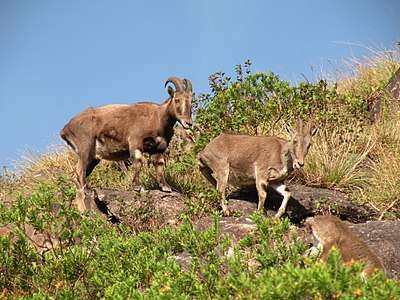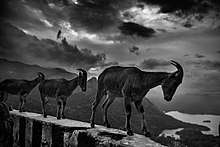Nilgiri tahr
The Nilgiri tahr (Nilgiritragus hylocrius) is an ungulate that is endemic to the Nilgiri Hills and the southern portion of the Western & Eastern Ghats in the states of Tamil Nadu and Kerala in Southern India. It is the state animal of Tamil Nadu.[2] Despite its local name, it is more closely related to the sheep of the genus Ovis than the ibex and wild goats of the genus Capra.
| Nilgiri Tahr | |
|---|---|
 | |
| Male (left) | |
_female.jpg) | |
| Female Eravikulam National Park, Kerala, India | |
| Scientific classification | |
| Kingdom: | Animalia |
| Phylum: | Chordata |
| Class: | Mammalia |
| Order: | Artiodactyla |
| Family: | Bovidae |
| Subfamily: | Caprinae |
| Genus: | Nilgiritragus Ropiquet & Hassanin, 2005 |
| Species: | N. hylocrius |
| Binomial name | |
| Nilgiritragus hylocrius (Ogilby, 1838) | |
| Synonyms | |
|
Hemitragus hylocrius | |
Etymology
In Tamil, the Nilgiri tahr is called வரையாடு (varaiaadu). The word varaiaadu is derived from the Tamil words wurrai meaning "precipice" and aadu meaning "goat". The word in ancient Tamil was வருடை (varudai). In Malayalam, the word is വരയാട് (varyaadu).[2] The Nilgiri tahr was described as Capra warryato by Gray.[3]
The genus name Nilgiritragus is derived from the Tamil word Neelagiri meaning "blue hills" and the Greek word trágos meaning "goat".[4][5]
Taxonomy
Its closest relatives are sheep (genus Ovis). Until 2005, it was placed with the Himalayan tahr (Hemitragus jemlahicus) and the Arabian tahr (Arabitragus jayakari) in the genus Hemitragus. However, it has recently been transferred to a new genus Nilgiritragus because it is genetically more similar to members of the genus Ovis than to other tahrs.[6]
Description
_juvenile.jpg)
_female_head.jpg)
The Nilgiri tahr is a stocky goat with short, coarse fur and a bristly mane. Males are larger than females and of darker colour when mature. Both sexes have curved horns, reaching up to 40 cm (16 in) for males and 30 cm (12 in) for females. Adult males weigh 80 to 100 kg (180 to 220 lb) and stand about 100 cm (39 in) tall at the shoulder. Adult males develop a light grey area on their backs, thus are called "saddlebacks".[2]
Habitat and distribution
The Nilgiri tahr inhabits the open montane grassland habitat of the South Western Ghats montane rain forests ecoregion. At elevations from 1,200 to 2,600 m (3,900 to 8,500 ft), the forests open into large grasslands interspersed with pockets of stunted forests, locally known as sholas. These grassland habitats are surrounded by dense forests at the lower elevations. The Nilgiri tahrs formerly ranged over these grasslands in large herds, but hunting and poaching in the 19th century reduced their population.[1][7]
Conservation
_seen_at_Eravikulam_National_Park._Munnar%2C_Kerala..jpg)

As few as 100 Nilgiri tahrs were left in the wild by the early 20th century. Since that time, their numbers have increased somewhat; in a comprehensive study of the Nilgiri tahr population in Western Ghats, the WWF-India has put the population at 3,122.[8] Their range extends over 400 km (250 mi) from north to south, and Eravikulam National Park is home to the largest population. Per the wildlife census conducted by Kerala forest department in association with volunteers from College of Forestry and Veterinary Science under Kerala Agricultural University, from April 24–28, 2014, the number of animals in Eravikulam National Park has increased to 894 individuals. This is the highest ever count recorded in the national park, with the first census in 1996 finding only 640 tahrs.[7] The other significant concentration is in the Nilgiri Hills, with smaller populations in the Anamalai Hills, Periyar National Park, Palani Hills, and other pockets in the Western Ghats south of Eravikulam, almost to India's southern tip. A small population of tahrs numbering around 200 is known to inhabit the Boothapandi, Azhakiyapandipuram, Velimalai, Kulasekaram, and Kaliyal Ranges in the Kanyakumari district of Tamil Nadu [9] and another small herd of less than 30 animals is known to inhibit Ponmudi Hills in Trivandrum district of Kerala.[10]
References
- Alempath, M. & Rice, C. (2008). "Nilgiritragus hylocrius". IUCN Red List of Threatened Species. 2008: e.T9917A13026736. doi:10.2305/IUCN.UK.2008.RLTS.T9917A13026736.en.
- Prater, S. H. 1948, 1971. The book of Indian Animals, Bombay Natural History Society and Oxford University Press, India. 324 pages. ISBN 0195621697.
- Hamilton, General Douglas (1892). Hamilton, Edward (ed.). Records of sport in southern India chiefly on the Annamullay, Nielgherry and Pulney mountains, also including notes on Singapore, Java and Labuan, from journals written between 1844 and 1870. London: R. H. Porter. pp. 284. OCLC 4008435.
- Lengerke, Hans J. von (1977). The Nilgiris: Weather and Climate of a Mountain Area in South India. Steiner. p. 5. ISBN 9783515026406.
- Liddell, H. G.; Scott, R. (1940). "τράγος". A Greek–English Lexicon (Ninth ed.). Oxford: Clarendon Press.
- Ropiquet, A. & Hassanin, A. 2005. Molecular evidence for the polyphyly of the genus Hemitragus (Mammalia, Bovidae). Molecular Phylogenetics and Evolution 36(1):154-168
- "Munnar Hill Station". Kerala Tourism. Archived from the original on 18 January 2014. Retrieved 21 June 2012.
- "Nilgiri tahr population over 3,000: WWF-India". The Hindu. 3 October 2015.
- "Bonnet Macaque tops in wildlife survey in Kanyakumari district"
- "Squeezing Life out of Ponmudi"
Further reading
- Rice, G. Clifford, Reproductive biology of Nilgiri tahr, Journal of Zoology, London (PDF)
External links
| Wikimedia Commons has media related to Nilgiritragus hylocrius. |
